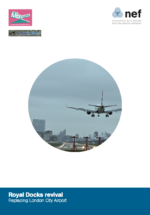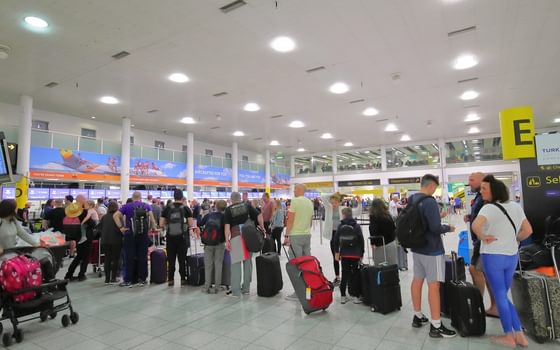Royal docks revival
Replacing London City Airport
10 April 2014
London City Airport occupies a large and valuable strip of land at the heart of London. Does it make sense to locate an airport in such precious inner-city space? What if we reclaimed this historic site and built a new neighbourhood, incorporating the best thinking about sustainable urban design?
The Royal Docks is an important area of the UK capital. London City Airport occupies land that could be redeveloped as a sustainable and socially just neighbourhood, complementing current regeneration plans for east London and inspiring transformation across the capital and beyond.
With the real and pressing need to transform our cities for a sustainable future, we must begin to seriously question the logic of locating an airport on precious inner city land. We can and should close London City Airport.
The case for closing London City Airport
Set in a prime location, London City Airport carries a very high opportunity cost in the traditional economic sense, but also in a social and environmental sense. It contributes to London’s poor air quality, carbon emissions and community blight in surrounding Newham (already one of London’s most deprived boroughs), and causes noise pollution across much of east and south-east London. Generating relatively few jobs for locals, its benefits are felt almost exclusively by wealthy business people travelling to and from Canary Wharf and the City of London.
Now is the perfect time to think about alternatives. Crossrail, due to be operational within five years, will dramatically cut journey times between east and central London and London-area airports, allowing City workers to access Heathrow in just 30 minutes. At the same time, the current review of aviation capacity in the south-east should give us a chance to radically rethink the management of UK aviation.
A sustainable neighbourhood vision
With 70% of the world population expected to live in urban areas by 2050, cities must lead the way in demonstrating how we can rapidly reduce carbon emissions, live within our environmental limits and achieve a fairer distribution of economic benefits. If London City Airport was closed, we could replace it with a beacon of innovation that could generate huge value to the local community and Londoners more widely. This report explores an alternative vision for the site. Based on examples of sustainable cities worldwide and conversations with local people and experts – including architects, planners, social geographers and investors – we identified six key characteristics of the new sustainable neighbourhood:
- Natural design: Architecture is playful and fun, inspired by nature in its structure and materials to increase resource efficiency. It generates more renewable energy than is consumed in the neighbourhood. Buildings are a growing landscape, creating space for food production and wildlife.
- A layer cake of activities: Buildings are a ‘layer cake’ of different activities, with shared social space at the top and a mix of residential and flexible work space below that can be adapted to the needs of the people using it.
- Convivial: Everything, from work to home to leisure, is within walking distance. Children live no more than five minutes away from green play areas. Shared spaces and cultural venues encourage interaction, and the mixed size and affordability of housing stock ensures a diverse community.
- A cooperative neighbourhood: Community ownership ensures that housing and workspaces are permanently affordable, and that locals get a stake in the area’s renewable energy infrastructure and other assets.
- A dynamic connected economy: A new business economy is encouraged, designed on cradle-to-cradle principles which treat waste as a valuable asset, and where products are made to be reused.
- A place to visit: thanks to new attractions, and easy and fast access via Crossrail, the area becomes somewhere that people from London and beyond want to visit.
Cities can evolve into net producers of renewable energy, food production centres and convivial places to live and work. But this means taking a much broader view of value-creation, encompassing social and environmental as well as economic benefits now and in the long-run. It also encourages thinking about who value is created for when land is used for particular purposes. We need to transform current patterns that lock local people out of their own neighbourhoods – through deprivation, inequality of resources, or through lack of a local voice.
Our argument is that more healthy, resilient and sustainable economies will depend on a framework for fairness and access to decent livelihoods; a framework that creates opportunities to achieve greater well-being for everyone.
Image credit: erg0 via Flickr
Topics Climate change Environment Industrial strategy Transport







